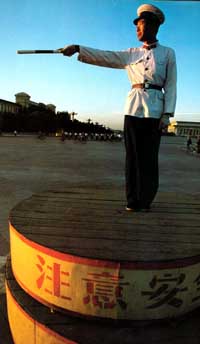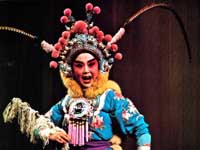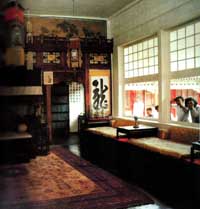by Chalerm Raksanti
Today, despite the Spartan living conditions of most of
China, and a government whose control reaches into the most intimate
aspects of people’s lives, many Chinese, even those in Beijing, closest
to the center of control, manage to enjoy happy lives with their families,
to pursue their private passions, and to find please in unlikely places.
 A
baton-wielding traffic policeman stands on a platform in Tiananmen Square.
The sign warns, “Pay attention to safety.”
A
baton-wielding traffic policeman stands on a platform in Tiananmen Square.
The sign warns, “Pay attention to safety.”
Far from being the soulless blue ants of yesteryear,
the people of the city are avid movie-goers, tireless tourists and sports
enthusiasts. At dawn, the parks of Beijing are filled not only with old
folks, moving through the ancient rhythms of taijiquan, but also with
legions of young joggers and aerobic exercise freaks. Settling into the
city’s rhythms one must learn where to look. Stamp collectors meet on
park benches and sell or exchange their postage stamps from around the
world. Some people congregate with pets, pedigreed Western dogs, caged
songbirds, and amateur horticulturists abound.
 This
pheasant-plumed actress impersonates a warrior in a Beijing Opera
production.
This
pheasant-plumed actress impersonates a warrior in a Beijing Opera
production.
But the center of life for the Chinese is unremitting
labor. They have overcome Beijing’s natural handicaps and the ravages of
successive invasions, and established the city as a world capital.
Ambitious irrigation schemes, some begun more than 2,000 years ago,
transformed the arid North China Plain into a productive agricultural
region. The Grand Canal was extended in the 7th century to link the
Beijing region to the towns of the Yellow and Yangtze River Valleys.
 Seat
of power during the Quing Dynasty, the imperial throne stands in the Hall
of Mental Cultivation in the Forbidden City.
Seat
of power during the Quing Dynasty, the imperial throne stands in the Hall
of Mental Cultivation in the Forbidden City.
Since 1949 the Chinese have also added thousands of
miles to their rail network to tie the rest of China more closely to the
capital. Beijing’s people are tough and resilient. Their ancestors
labored to build and rebuild the city and over centuries impressed their
own character on it, triumphing over a harsh climate and foreign
invasions, and surviving indifferent and brutal leaders. Today’s
citizens are worthy successors, and their city’s survival and growth
make it a fitting symbol for all of China.
 In
Beijing, as many as 500 bicycles may cross an intersection every minute.
In
Beijing, as many as 500 bicycles may cross an intersection every minute.
Finding your way around Beijing is relatively simple.
Surviving to tell the tale is something else. A Beijing traffic jam is a
lurching, heart-stopping amalgam of motorcycles, three-wheeled vans,
articulated buses with accordion-pleated center sections, and in all of
this mess seems all the city’s 4 million bicycles molded into a thriving
hive of flexing leg muscles and elbows. The basic rule of the road is that
the streets belong to the cyclists who ply the roads as though other
vehicles do not exist. Heedless of stoplights and pedestrians, the traffic
virtually hums like a wasp’s nest. The beleaguered traffic policemen try
to restore order, but nothing works for very long. When Chinese are in a
hurry, red lights, traffic cops and lane markings mean nothing at all.